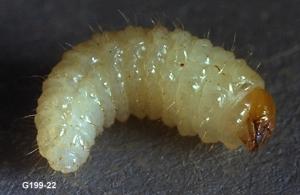CONTENTS
Identification
Management
Sampling
and Action Threshold
Development Model
Registered
Insecticides
References
[Insect
Management]
[Home]
|
|

The major root weevil species attacking mint is the strawberry root weevil, Otiorhynchus
ovatus. However, the black vine, O. sulcatus, rough strawberry, O.
rugosostriatus, and obscure root weevil, Sciopithes obscurus, also may be
present in some mint fields.

Most strawberry root weevils overwinter as
larvae in the soil, but a few adult weevils also overwinter in protected areas. These
adults are the first to deposit eggs the following spring. Overwintering larvae mature
during the end of April and early May and form earthen cells in the soil where they
pupate. Adults begin emerging during mid-May and early June and are usually present in
mint fields through late September (Cacka, 1982; Emenegger and Berry, 1978; Emenegger,
1976). All adults are females and, in the absence of fertilization by males, begin
depositing eggs around the bases of plants about 2 weeks after emergence. Most of the eggs
are deposited during late June and July. There is one generation each year. Select Development
Model from the contents menu to calculate a degree-day model for strawberry
root weevil.
The accumulation of day-degrees (DD) may be used to predict the occurrence of the
different life stages of strawberry root weevil using a base temperature threshold of
8.8oC (48oF) and accumulating DD above the threshold beginning January 1. For instance, in
central Oregon, overwintering larvae are found in soil samples until late May or early
June (Cacka, 1982). Pupae are present in samples from late April
to early June (350 DD). Peak pupation occurs from mid-May to early June. Teneral adults
are present in late May to early June (500 DD) and peak adult emergence occurs in mid-June
and early July (700 DD). Development of ovaries and subsequent egg laying usually begins
about 2 weeks after adult emergence or after about 950 DD have been accumulated. Control
of adults with insecticides in central Oregon should be timed to coincide with the
accumulation of about 700 to 800 DD in early July. Development of all stages of strawberry
root weevil occurs earlier in western Oregon; pupae and teneral adults are present in soil
samples in early May and most adults have emerged by early June. Therefore, applications
of insecticides for adult control in western Oregon should be made in mid-June.
Larvae begin feeding on small mint roots very soon after emerging from the eggs (the
majority of larvae emerge during late July and early August, 1300 to 1400 DD). Larvae feed
through the summer and early fall, at which time they reduce activity until the following
spring when feeding is resumed. In western Oregon and Washington, where winters are mild,
the larvae may continue feeding during the winter months.
Adult damage, which may be evident during late May, June and July, consists of small
notches on the leaf margins and stems, particularly near the soil line. Adult feeding on
mint is usually inconspicuous and is not economically important. Adults are active on mint
foliage at night after sunset and by dawn have usually descended to the soil surface and
become inactive during the daytime in cracks or under sheltering debris.
Natural spread of root weevil infestations in and among fields is gradual because adults
do not fly. Serious infestations can originate when roots and rhizomes are dug from
infested fields and transplanted in uninfested areas. Obviously, growers buying mint
rhizomes for new plantings should purchase "weevil free" rootstock, or at least
remove as much of the soil as possible from rhizomes to be transplanted. |


